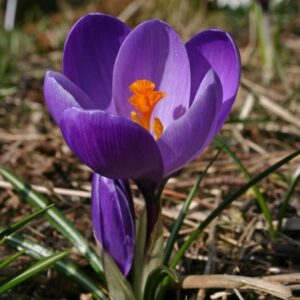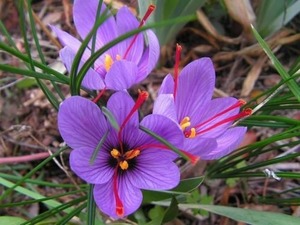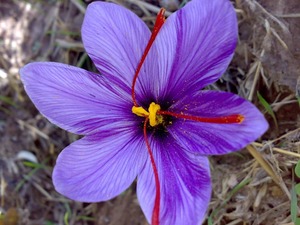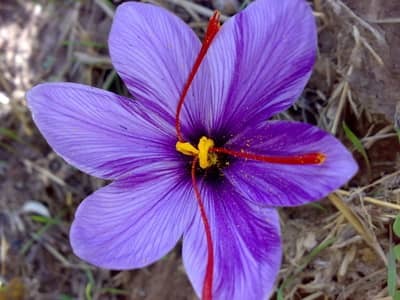Growing your own spices can be very rewarding, but many don’t know where to even begin. The spice “Saffron” is actually a pretty easy, beginner level plant, and this article will not only explain exactly how to grow it, but also some other useful knowledge about the expensive and exotic spice.
To grow saffron, you must find a place to purchase saffron crocus bulbs. Plant bulbs outside during fall. Saffron needs well-drained soil, plus lots of sunlight. The bulbs must be planted a few inches deep, and about 6 inches apart. They need minimal maintenance, since they’re fairly sturdy plants.
Although planting saffron seems pretty straightforward, there are some details you need to pay close attention to when deciding if you will be able to dedicate the time and effort that goes into prepping and harvesting the plant.

Where To Begin
First, why do you even want to grow saffron? Saffron is actually fairly expensive, so many people, whether they know a lot about gardening or not, decide it would be more cost efficient to just grow and harvest the spice themselves. The plant can fit right in next to other herbs, spices, fruits, and vegetables so it makes plenty of sense to do so. Others might just love the taste of saffron and want to always have some on hand and keeping a garden of the saffron crocus bulbs is a smart move.
Saffron is time-consuming & labor-intensive
It can take some time to grow the spice, though, so patience is the key. If you’re looking to make a profit, you may want to look into growing a different crop. Saffron takes a lot of time and hard labor to harvest, especially in large quantities, and there isn’t going to be enough payoff if you only have the space in your backyard. This is a plant that’s better grown by large companies & farms.
Where to get saffron crocus bulbs
To acquire saffron crocus bulbs, you can visit your local nursery and check for them there. If your nursery doesn’t currently have them, you might ask if they could purchase them from someone else for you. If that isn’t an option, you can easily find a reputable online nursery and have them shipped to you, though not all online nurseries will stock saffron crocus bulbs. And they might not be in season at all stores, so it might take some time to hunt down a place that has them in stock.
They are often sold out, but it’s good to note that many websites have the option to email you when they’re restocked!
Once you have finally acquired your bulbs from a nursery, now it’s time to figure out when exactly you should begin planting them. These plants bloom in the fall, so you will want to also plant them in the fall. You most likely won’t see any results until the following autumn, so just be patient. Be sure to plant your bulbs right after you receive them, as they do not store very well.
About Saffron
What even is saffron? Well, it’s a bright orangey-red seasoning used in many different types of foods, like curry, bread, and even sweets, all across the world. It gives a bright color to dishes and is quite popular in many corners of the Earth. Maybe you’ve never had saffron before, or you have but it was in a dish with other strong flavors, so you aren’t quite sure if you want to add it to your garden.
The saffron spice itself specifically refers to the strings that spring out of the middle of the flower of the saffron crocus. The strings, also known as stigmas, get harvested from the purple blooms.
Harvesting saffron
To harvest saffron, you have to wait for the flowers to bloom, which occurs in the fall. The red-orange stigmas that stick out of the flower are what the saffron spice comes from.
Pluck out those stigmas–very carefully. It’s a delicate, time-consuming process–that’s why saffron is so expensive.
The stigmas need to dry in a warm place. Put them on a cookie sheet in a sunny spot will do–you don’t need to put them in the oven.
Once they’re fully dry, they’ll easily crumble. So be careful–do NOT crumble them! Store the entire stigmas in an air-tight container.
Saffron should last about two years.

How to grow saffron for profit
You might be wondering how many saffron plants equal just a tablespoon of the spice.
Well the answer to that question is 50 to 60 saffron flowers will get you a single tablespoon of the pricey seasoning.
Keep in mind, also, that one bulb produces one flower, and one flower produces three of the red-orange stigmas. It’s also good to remember that saffron crocus will multiply each year, so you will have plenty after a couple years to always have a supply of saffron.
Many people talk about how saffron is worth its weight in gold, and that’s why it’s a great seasoning to grow at home. For a pound of saffron, it can cost anywhere from $500 to $5,000 wholesale, or $5,000 to $10,000 retail.
It’s the most expensive spice for good reason, too! To even get a single pound of the spice, you would have to plant a huge field of the bulbs, and then hand pick each of the stigmas from every flower. It’s a painstaking process, but worth the time for sure.
Planting saffron and its upkeep
Make sure when you’re preparing your garden to plant your saffron crocus bulbs, that you have a fairly light soil that is very well-draining. The bulbs will rot if left in a swampy, wet environment. And that’d be super frustrating & a huge waste of time and money. So it’s best to avoid it in the first place.
Remember that the bulbs should be planted about 4 inches deep into the soil, and about 6 inches away from other bulbs to give them plenty of space to grow and prosper.
Sun requirements
Saffron plants also really love sunlight. Planting them outside away from shade, or plant them in a sunny spot or in a greenhouse that gets full sun. That way, they’ll get plenty of sunlight–it’s the best way to ensure your plants flourish and live a long, fruitful life.
Preferred temperature
Saffron crocus are actually pretty hardy plants. They can withstand temperatures as low as -15o F (which is around -26o in Celsius). That said, saffron does best in USDA zones 6 though 10.
If you’re in a zone with colder temperatures, especially during winter, you’ll want to prevent the cold from killing your saffron plants. Either invest in a climate-controlled greenhouse, or you’ll need to bring the plants inside during winter. At the very minimum, saffron crocuses need to be kept out of the coldest winter conditions.
If you do bring your plants inside, dig them up and place them in a large container and cover them with moss or sand. Store them in a cool, dry place. Then, in early spring, and re-plant them when the freezing temperatures and frost have moved on. But: don’t water them until you start seeing new growth.
Watering
The bulbs need around an inch and a half of water per week at least. If your area gets less rainfall than that, you will need to water them yourself. If not, let nature do its thing and they should be fine.
Like I’ve mentioned a couple times already, these are pretty hardy plants and they don’t need much maintenance.
You can fertilize the plants once a year if you would like and feel it’s necessary, but they should do just fine with no fertilizer. Other than those extra tidbits, there really isn’t much else these plants need besides time and patience to grow.

Related Questions
Where does saffron grow best?
Saffron crocus grows best in warmer climates with lots of sun and well-draining soil. If you live in a cold environment but want to grow saffron, look into starting a greenhouse where you can control the temperature to properly grow the spice.
How long does saffron take to grow?
Saffron takes about a year to go from just the bulb to a flower with stigmas ready for harvesting. This can be a little off-putting to some, since it takes a while to see the fruits of your labor, but it is definitely worth the wait.
Is growing saffron profitable?
For a home gardener, no, it’s not. Even with a huge field of saffron plants, it would take tons of manual labor and time to harvest each of the tiny stigmas. And unless you can build a large commercial company and hire plenty of people to do the work for you, it’s just not reasonable. This one may be better left to those more well-equipped to run a large business.
What does saffron taste like?
Saffron has an earthy-nutty type flavor. If you use too much of it, it gets slightly bitter, so it’s definitely a spice used best in moderation. Saffron is common in main dishes and desserts–it has a vanilla-like taste and savory spin. It’s a unique spice and is often highly recommended by those who have tried it.

